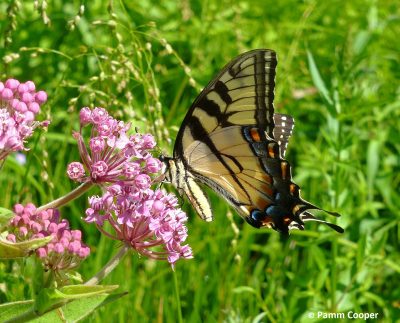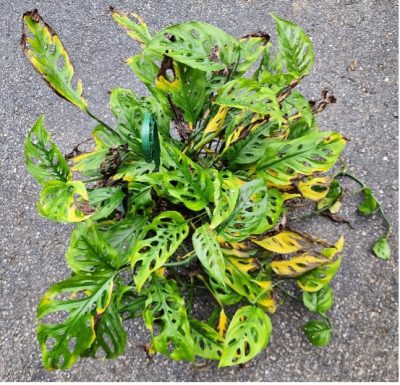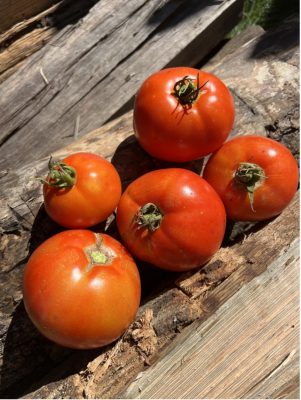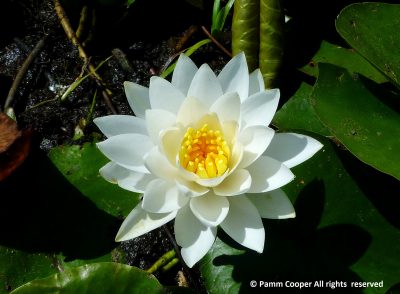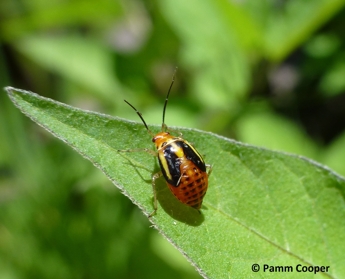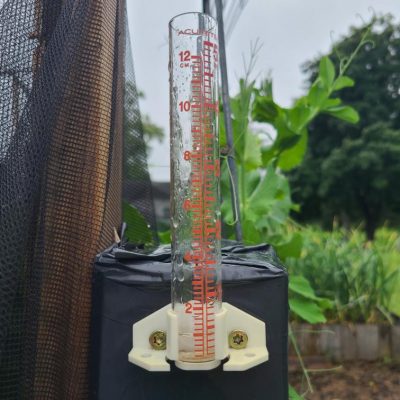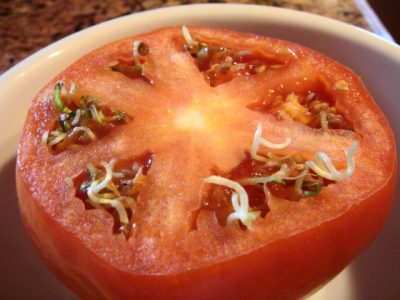00:00:01 Stephen Thal
Hi, welcome to another segment on Focal point. This is Stephen Thal and I'll be your host for today's informative program.
Our guest today uh is known to us. She's been on several times in the past year to help us understand more about living plants, whether you have them inside your house, or you put them outside or you're doing gardening and she's also part of the UConn plant science program and they offer many, many services which she'll be explaining sometime during her presentation today.
However, to kick this off. We have to be more cognitive of the weather, the types of weather we're having. Examples include drought, some places there's too much rain, so here to help us straighten it out and get some good plant life going. Is Heather Zidack back from the UConn Plant Science Center. Welcome, Heather.
00:01:00 Heather Zidack
Hi, Steven, thank you for having me.
00:01:03 Stephen Thal
So let's take a look at the weather pattern. Weather patterns have been infected- impacting plants.
00:01:11 Heather Zidack
Yes, it has been a very notable spring this year with the amount of rainfall that we've had. But before I talk about the rainfall, I want to just go back a little bit because we've actually seen effects from last fall in our garden. So what happened at the end of last summer, early fall and into the winter, if you remember, we were actually in a drought through most of the state.
And that lasted through March of this year. And so because a lot of plants went into the winter under drought conditions, we actually saw a combination of the lack of water with the heavy winds from this winter and it caused a lot of moisture to be pulled out of those plants.
We saw a lot of winter kill, so broadleaf evergreens, rhododendrons, mountain laurels, all sorts of shrubs like that, anything needled evergreens as well. A lot of arborvitaes Japanese Hollies, things like that. We saw the-uh They turned brown and then they ended up just kind of dying back. Luckily with a little bit of care, homeowners have been able to bring some of them back and at this point in the season, we're starting to look more towards disease causes, but this was seen all over the state, so we had this drought in the fall.
And then here we are in March and April, seeing the effects of it. So everything that happens is cyclical and we see it happen in the next growing season. And then here we are now with significant rainfall. I think it's rained-What every weekend for quite some time now.
00:02:52 Heather Zidack
And that rainfall in May was enough to pull us out of a moderate drought across the state, except for like one small area in Fairfield County who is abnormally dry, which is the lowest rating that you can have in drought conditions. So that's really good.
The expectation for the next month or so is average. So you want to start to monitor your gardens and make sure that if we're getting an inch to two inches of water a week, we have enough water for our plants, for the most part. If we're seeing less than that, we've got to get out and start checking the soil and get into the habit of watering so that when we get into the next fall that we have coming, we don't get used to not watering and then seeing plants decline from that. Because I think that was something we saw last year as well as we had a very wet spring and when we got to the fall.
00:03:47 Heather Zidack
Not only did we have a drought from the environment, but a lot of us didn't get trained, we'll say, to go out into our gardens every day or two to check to make sure the water was there, because we just relied on it coming from the sky. So that's been a really huge impact that we've seen over the the last season in our gardens and we're just getting started with growing.
00:04:10 Stephen Thal
Wow, what are some plants that are directly impacted by this?
00:04:15 Heather Zidack
So some of the things that we've seen, like I said, the evergreens were a really big deal.
A lot of stuff that's more shallow rooted is going to see more effect one way or another. It's going to have more signs of stress, but the bigger thing that we're seeing right now out in the garden-Once we've gotten passed into this spring and seen some of the shrub damage is looking at our annuals and what's happened with our annuals is we've looked at the temperatures and we've had some significant cold in comparison to previous springs. So when you have cold weather like we've had what we recommend. Is if it's 50° or more.
It's good to put your annuals, your house plants, your tomatoes, your Peppers, all of that outside. We've had a few weeks. I think it was the week before Memorial Day this year where those temperatures dip below 50 and so we actually saw a lot of people were covering their plants, bringing them inside, making those adjustments.
00:05:19 Heather Zidack
In order to protect their crops, because if they were left outside, although they would survive, they wouldn't necessarily die off. Turn brown and fall over and have to restart. You may notice things like the flowers dropped or they slowed down how they were growing, especially anything in the eggplant, pepper, tomato family once the temperatures get to like 60°, they pause development, so once it gets lower than that they start to get a little bit stressed. On the other side of it, our cole crops and our Greens have loved this weather. I just was out my garden this past weekend and I picked a giant basket of lettuce and spinach and all of that because these cool nights and warm days are really encouraging growth of those crops without sending them into flowering. So it's just something that kind of keep an eye on.
00:06:11 Stephen Thal
And uh, what about? Uh, you were talking about leafy lettuce. Uh, how do you take care of those? They're a little tender, aren't they?
00:06:20 Heather Zidack
They actually are pretty tough. What's really interesting is that once we usually get into this point in June, July and start getting into the heat of summer, they actually start to get a little bit more difficult to grow because they don't like the heat of the summer.
00:06:36 Heather Zidack
They'll start putting out flowers. They'll start wilting, using a little more water.
So we tend to not see them grow as well in the home garden in the high heat of the summer. You can protect them from that with any shade cloth or putting them in a shadier area because they're not producing anything like fruit or flower. They don't need to have as much of the sunlight as some of your other plants do that also applies to some of your your herbs like your basils and things like that, so they can go in a shadier spot if you have-
00:07:09 Heather Zidack
You know a spot in your garden that maybe is a little too shady for your tomatoes, but it might do OK for your leafy greens, your herbs and things like that. With the weather that we've been seeing too, it's really important to make sure that you're spacing your plants really well this year. You don't want to make them too close to each other, because crowding can often help when it comes to diseases and pests. They love tight, crowded areas, so if you space out your plants really well this year-You're going to help reduce that pressure when we start seeing the hotter temperatures, some of this humidity that we get in the summer and things like that.
00:07:51 Stephen Thal
Now when you're asking when you're working in the garden. Should you be wearing gloves to protect some of the insect bites you get, or some damaging to your hands?
00:08:04 Heather Zidack
Absolutely. I wear gloves when I'm in the garden all the time. I do it for a couple of reasons. I have, you know, I like to protect my my manicure, right? So I keep my gloves on. But it also is really good. Like you said, if you have got insects in the garden, but like I've seen this Spring because of all the rain that we've had, my garden is actually close to a wetland and we've had a lot of mosquitoes. So I found myself actually going out with not just gloves but long sleeves, long pants and close toed shoes and a hat, just to make sure that I'm protecting myself as best I can from the insects.
00:08:46 Heather Zidack
It's a good thing to do, just to have that extra layer of protection when you're pulling weeds. You never know when you're going to have something that you know might just interact with your skin or something like that. So definitely I wear gloves all the time in the garden and I do recommend it for everybody that's out there.
00:09:05 Stephen Thal
And what about? Uh, you had mentioned to me about you shouldn't walk on wet soil. What does that do?
00:09:15 Heather Zidack
Yes, so especially this spring with all the rain that we've had and everything, gardens are starting to get a little bit flooded a little bit waterlogged. So the first thing that we recommend is don't walk on the soil when it's wet if you can, especially when it's been really saturated after some of the rain that we've had these past few weeks.
00:09:35 Heather Zidack
What that does is that compacts the soil and it squishes it down and closes a lot of those air pockets that are there between the soil particles. So that makes it harder down the road for water to penetrate and get into the soil and to the roots of your plant. So if you do have either saturated soils or this is good if you're just checking your water needs in the garden, it's a really good thing to get tactile with it and use your hands so.
00:10:04 Heather Zidack
You want to dig down a little bit. You want to grab a little handful, squeeze it in your hand if it. If it's really dusty, really dry. We all know what that feels like. And so that's when your plants are usually gonna need water. If when you squeeze your hand, you've got water running out of your hand, it's gone the other way. And it's definitely saturated. You don't want to walk on it. You don't want to add any water you wanna try to keep your plants where they are so they can dry out a little bit.
00:10:33 Heather Zidack
If it's somewhere in between and it holds a form, but it doesn't have any water coming out of it. That's like that sweet spot where you're like, OK, I have enough water for now. I can come back tomorrow and check. So that's really the best way is to to look and use your hands as you're exploring your garden to make sure that it's well watered. Don't rely on appearance because a lot of times some of these garden products that we have can look wet or look dark compared to what the soil is and so it can be a little deceiving. So you want to always make sure you're checking with your hands instead of using your eyes to take a look.
00:11:13 Stephen Thal
OK, how about, uh, some of the insects like squash bugs and so on. Uh, are they helpful to the garden or harmful?
00:11:23 Heather Zidack
They are opposite, they are harmful to the garden, so they are coming. Squash bugs usually start coming out-Wanna say end of June, early July, there's squash bugs, there's squash borers, there's things like that. And with those, if you're growing squash plants, you wanna try to remove them as early as possible.
00:11:44 Heather Zidack
They are something the squash vine borer I'll start with is one that lives in the soil. Once that hatches, it crawls out and chews into the stem and the larvae lives in the stem. So if you see a squash plant that's wilting and doesn't look so hot, if you trace it back to the stem in the ground, you might notice it almost looks like...um..It's it's not, but it almost looks like wood shavings. You'll see where it like burrowed into the stem if you cut that stem open, you'll probably find some kind of Caterpillar in there and they move quick. They move like a foot a day, so that's one to watch out for.
00:12:22 Heather Zidack
The squash bugs are a little less dramatic, but you'll notice they're eggs on the underside of leaves, and what I recommend for people who are dealing with squash bugs to do is remove them by hand, take a piece of duct tape, wrap it around your hand backwards, and just stick your hands to the leaf. It's enough to pull those eggs off without having to use any chemicals or pulling the leaves off the plant. It's a really effective method.
00:12:47 Heather Zidack
If you want to go a step further and you're out in the garden and you're deciding to plant your squash, it's mid-June so you could maybe plant this weekend if you're doing that, you could put netting onto your plants. As long as it's not the same place it was last year and that will help the adults from flying in and getting onto your plants in the 1st place. So that's a really good thing to.
00:13:12 Heather Zidack
You there's other bugs out there as well. In the summer, there's a lot of insects. If you've had a garden, you know there's a lot of bugs out there. Usually you can't tell by just the damage left. You need to find an insect that it's in action to treat your plants.
00:13:28 Heather Zidack
Because what we recommend doing is, it's called integrated pest management, or IPM. They have-in using that method, you're using your targeted approach to get rid of a specific insect that you have identified using specific methods. That way we're not overusing any products in our garden. We're not going and over exerting ourselves to take care of the issue. It's a smart approach and a targeted approach to whatever your garden problems are.
00:13:56 Heather Zidack
With that being said, this is a little personal plug here for the Home and Garden Education Center, but we will be hosting a home gardener seminar for integrated pest Management in August, so it's a multi speaker event. We have tips to manage pest disease, and other things in your garden and that's going to be coming up in August. If you'd like to get information about that, you're welcome to either call or e-mail us and we can put you on the list to let you know when that releases. But it's something that helps make that targeted approach. Couple of other insects that are out there right now are things like the four lined plant bug that does a whole lot of damage. It's damage, looks like like little brown spots all over leaves. I've seen them on basil. Specifically, they have a bunch of hosts, but I know they love my basil at home.
00:14:50 Heather Zidack
There's this spittle bug which has little foamy...Nests will say they're not really nests, but they're little foamy structures that they put around the center of a stem. When they're there, they're a short-lived insect that just kind of does its thing and dives out in the environment, and we don't even need to treat it. There's aphids. There's all sorts of things, so that's when learning what you're looking at can guide how you're treating it so that you're not using as many products in the garden.
00:15:19 Stephen Thal
Huh. What are my mosquitoes? How do you deal with mosquitoes?
00:15:24 Heather Zidack
Mosquitoes are different, but very interesting in the garden, so they're definitely out. Like I said, I am near a wetland, and so I'm definitely experiencing them out in the garden frequently at this point. Best thing to do when you're dealing with mosquitoes in your yard is if you are out.
00:15:44 Heather Zidack
They come out at dawn and dusk, so being outdoors at those times, you want to wear bug spray, especially like when that's when they're most active.
00:15:52 Heather Zidack
If some people do wear bug spray throughout the day because in areas that are bad, they're always out there. So it really depends on what your yard is like. After rain, you can dump out any containers they've caught water because what they do is they lay their eggs and their larvae actually live in water before they go into the air. So you want to make sure that the air-that the water is dumped. You want to empty any of your bird baths and rinse them regularly for the same reason.
00:16:24 Heather Zidack
And one thing that's really interesting with mosquitoes is we see a lot of mosquito repellent plants that are sold and advertised to us and this is a big thing for a lot of people. One thing that I warn people about with this is that their job as a mosquito repellent plant is to keep the mosquitoes away from the plant itself.
00:16:46 Heather Zidack
So it's an immediate proximity.
00:16:49 Heather Zidack
What we do is we tend to harvest the oil from these plants and put them into repellent products. So like the citronella plant for example, or lemongrass or things like that, we extract those oils and then use them in our insect repellents. It's not necessarily going to protect you if you have a pot of lemongrass on your patio because it doesn't have an 8 to 10 foot range. It only has a few inches around that plant that really has that repelling effect, so.
00:17:21 Heather Zidack
That's how that works. They're great to have, but also just to keep in mind, with that, we never recommend crushing or rubbing any kind of plants on your skin without first consulting with a doctor or an allergist just to make sure that you're safe and you're doing what's best for your health.
00:17:39 Stephen Thal
This is Stephen Thal with another segment on Focal point and we're interviewing Heather Zidack from UConn Plant and Science Department up in Storrs.
00:17:49 Stephen Thal
And she's been leading us through the different weather patterns and also how some of the plants are impacted. And we also were talking about some of the oils that plants develop and how effective they may be in various stages.
00:18:06 Stephen Thal
It's very interesting and I think something else we got to take care of here is how do we, what kind of soil do we use and what kind of fertilizers we use, right, Heather?
00:18:17 Heather Zidack
Yeah. So soils are really important because that's the foundation of your garden. That's really where the not just your plants are taking root and and having their structural support, but also that's where the plants are gonna pull everything from nutrition, water and everything that they need. So whenever you have a garden, we always recommend calling our the soil Nutrient Analysis lab, either the one at UConn or the experiment station to have your soil tested. We recommend testing every two to three years and what they do is they look at the nutritional value of your soil. They don't look for anything else, but they will tell you what the nutrient levels are.
00:19:00 Heather Zidack
Are and I know with the UConn Labs specifically, what they look at is are specific values and how it would relate to your garden. So if you fill out a report that says I'm looking to grow vegetables, they'll kind of help you figure out what amendments you need to make for your garden to grow those vegetables. I can't speak. For what the experiment station does, but they are available as a resource for the public as well. And sometimes it just comes down to who's closer to you and how do you want to move forward and what information you want to get?
00:19:35 Heather Zidack
So that's really important. Get your labs and get your soil tested and figure out what your nutritional values are. Really important for, especially vegetable gardens, where nutrients are are kind of going through the systems a lot quicker than in established beds.
00:19:55 Heather Zidack
A lot of trees and shrubs and perennials that are established may not need fertilizer every year. They might need it every other year. It really depends on the species. There are some native species that rarely need fertilizer at all, so know what plant you have and then we can look into it a little further.
00:20:14 Heather Zidack
But like I said, those vegetables tend to have high demand and need more support because they're producing food for us. So what you want to look at are big three, our nitrogen, phosphorus and potassium or we say NPK. Your nitrogen is responsible for growing really lush leaves. Your phosphorus is really good for things like flower, fruit, a lot of your bloom booster fertilizers tend to be high in phosphorus, and your potassium is good for root growth, drought resistance, it helps to reduce some water loss, and they're still researching a lot of these things.
00:20:51 Heather Zidack
But what you look at when you're buying a fertilizer for your garden is you look for there's three numbers on the bag a lot of times it's and it's a lot of times in increments of 5 but not always. So like a 5-5-5, 10-10-10, something like that. These are percentages by weight of those nutrients in the bag. And they go in the order of nitrogen and then phosphorus, and then potassium. So sometimes they can be comparable to each other when you're working with a product because they're balanced in ratio. It really depends on what you need to apply.
00:21:25 Heather Zidack
A lot of the tone products that we see and weekly fertilizer products are much lower concentrations. So I've seen some fertilizers out there that are like 3-4-3, very low, but just a little bit of food to keep them going because if you're over applying, you can actually cause damage by providing too much fertilizer.
That's another reason going back to that soil test can be really important.
00:21:50 Heather Zidack
You always want to check the back of the bag. There is usually going to be not just those big three nutrients that we need, but also a lot of micronutrients as well, and that will vary in your soil as well. And when you get a soil report, you get all of that information.
00:22:08 Heather Zidack
Another really important thing is to stop fertilizing in August or September because-What we want to avoid is pushing any tender growth before frost, so if we start backing off in August and September, especially with some of these slow release fertilizers, we're not gonna continue feeding the plant and encouraging it to put out tender young leaves that then get bit by frost.
I think that's pretty much most of the soil rundown, a crash course.
00:22:38 Stephen Thal
Yeah, that's important. Thank you.
00:22:40 Heather Zidack
Would you like the number for the soil lab?
00:22:43 Stephen Thal
Oh, definitely.
00:22:45 Heather Zidack
All right, so this is for the UConn Soil Analysis Lab and it's 860-486-4274. Again 860-486-4274.
00:23:01 Stephen Thal
Great. Now after all of this, what else should we do to keep the gardens going?
00:23:09 Heather Zidack
So there's a lot of things that you can do right now. In June you want to be cutting back your perennials for sure that anything that has already flowered for your perennials you want to try to cut back. If you cut back some of these early flowering perennials at this point in the year, it may encourage them to push out new flowers. This happens very frequently in things like Salvia and Nepeta, which is known as Catmint as well. So if you cut back things that have already bloomed.
00:23:43 Heather Zidack
It will help encourage new growth and new flowers where you potentially. A lot of plants are in production mode right now. So they're producing fruit or flour for you. So water is going to be incredibly important. I went through all of the details with you before of like how to check your soil, but make sure that you can be checking your soil to see if there's enough moisture in there.
00:24:05 Heather Zidack
We don't recommend watering in the evening if you can avoid it. Early morning is going to be best because you're going to saturate that soil. And then it has the day to dry out instead of saturating at night, getting dark and cool. And then that's when there's a lot of rotten things that can happen.
00:24:23 Heather Zidack
You also want to avoid water on your leaves. You want to add water to the soil because if you have any droplets on the leaves, it can actually burn the plants a little bit. Believe it or not, plants can get sunburn, so you want to be careful.
00:24:37 Heather Zidack
It's also a good time to prune spring flowering shrubs immediately once the flowers are gone, so a lot of shrubs out there are like, again, I go back to rhododendrons, lilacs, things like that. They're gonna start to set their buds in this summer or during the fall. So if you prune too late, if you prune in the fall, when you're doing all your other cleanup chores or you prune over the winter like you do with your summer blooming shrubs. You could lose your seed-your
00:25:05 Heather Zidack
Lose your flowers. The next thing is that you can still plant from seed right now, so there's a lot of things out there that you can do. Radishes, beans, squash, carrots are all pretty quick to come up, so you could put those in the garden. Just check the back of the seed packet to see how many days till maturity we have and if it falls within, you know from here too. Let's say October, you've probably got a good shot in getting a crop. I know radish is an example only goes about 21 days in between seed to days to harvest. So that's really cool. I've even planted sunflowers in July after I've harvested.
00:25:45 Heather Zidack
My garlic needed to throw something in the bag, so there's a lot of really good plants out there that you can still plant in June. It does. It's not too late.
00:25:54 Stephen Thal
That's great.
00:25:55 Stephen Thal
We have about 6 minutes left. Anything you'd like to cover in the last 6 minutes?
00:26:02 Heather Zidack
Yeah.
00:26:03 Heather Zidack
Couple of really important things too. Looking at your house plants, so if you grow house plants and you want to put them outside, I think we finally hit that point where they can go out on the patio and be pretty comfortable for the rest of the summer.
00:26:18 Heather Zidack
Temps have stabilized for tropical and exotic plants that usually thrive indoors. So like I said, we look for that 50° at night and we're definitely there. It took a while, but we got there. If they haven't been outside yet and you're just putting them out soon, you want to start slow.
00:26:36 Heather Zidack
If you put them in a sheltered, shaded kind of outdoor space for a few days before you move them to full sun into the high heat of the day. So you wanna make sure that they have a couple of steps to take in between going from inside your office, let's say, from out to your patio. So that's something really important that you want to make sure that you're doing. The other thing that's really, really important, and I emphasize this with all gardeners at this point in the season is get yourself into the habit of making observations you really want to go out into your garden and take a look at the leaves. Take a look at the undersides of the leaves.
00:27:16 Heather Zidack
Take pictures. This is a great way to monitor so that if something does look a little different or disease develops or insects start showing up, you know early enough to do something.
00:27:29 Heather Zidack
I see a lot of times gardeners necessarily don't see what's happening in their garden, and then we hit a point where we're overwhelmed with disease or pest or weeds, even because of all the rain we've had. So if you can go out and get yourself in the habit of just looking at your plants, seeing what the leaves actually look like. Seeing what's normal and what's not normal.
00:27:52 Heather Zidack
That's really important to do so that when something abnormal happens, you're right on top of it and you can do something to save your plants instead of losing your fruit or your tomatoes or whatever the case may be.
00:28:05 Heather Zidack
If you do notice anything, it's really important to know that our office is here to help you with the UConn Home and Garden Education Center. We can always look at photos via e-mail. That e-mail is ladybug@uconn.edu again, ladybug @uconn.edu. Or you could call us at any time. Our number is 860-486-6271 again 860-486-6271 and we can help with plant disease as well as insects and environmental things that just look weird in the garden. We can help get you pointed in the right direction so.
00:28:49 Heather Zidack
That's definitely something that I I remind everybody is just be observant, be out in your garden, you know, be present with what you're doing. If you're out there watering, don't just go looking around at everything else around you go get the plants that you're watering and see what's going on.
00:29:05 Stephen Thal
Ah, that's great.
00:29:07 Stephen Thal
So we have to hope this is good information for our listeners and we have the phone numbers and we'll have them have you give it to them one more time.
00:29:18 Heather Zidack
So give you a couple of phone numbers, so I'm with the UConn Home and Garden Education Center. Again, my number here is 860-486-6271One again 860-486-6271. There's also the soil lab that I had mentioned earlier. Their number is 860-486-4274, again 860-486-4274. Between our two offices, we can definitely help gardeners get a handle on what they need to know.
00:29:55 Stephen Thal
Well, we thank you for coming into focal point. We always appreciate the invaluable information to help our listeners enjoy their garden, not only a garden if they're doing or house plants or combination thereof.
00:30:13 Stephen Thal
This is Stephen Thal with another segment on Focal Point.
00:30:13 Heather Zidack
Thanks for having me.
00:30:17 Stephen Thal
We hope you enjoyed today's program.
00:30:20 Stephen Thal
Two quick items for you. Please wear sunglasses and a hat when you're outside with the bright sun, and also to do a emergency plan for your home or for your business or whatever. And practice it very important to involve the people in case there is an emergency. People. Everybody knows what to do and that's the key piece.
00:30:47 Stephen Thal
So again, enjoy the Summer.
00:30:50 Stephen Thal
Stay safe and stay healthy, Steven Thal saying thanks to our guest speaker, Heather and all of our listeners that tuned in today.


